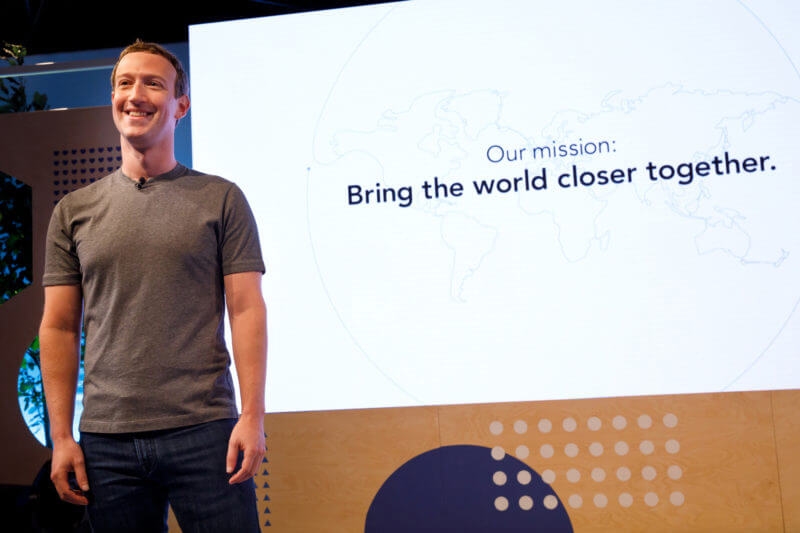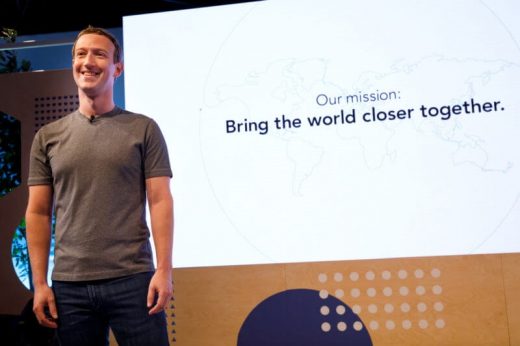Why businesses are relying on Facebook Groups to build engaged audiences
The community-building platform offers brands a backdoor into more engagement, deeper connections with consumers.

Facebook CEO Mark Zuckerberg at the company’s first Communities Summit in June, 2017.
At the beginning of 2018, Facebook switched up its algorithm in an attempt to “fix” the News Feed by promoting more posts from family and friends and demoting content from businesses, brands and media.
The move actively distanced brands from their followers on the platform by limiting exposure to organic content posted by businesses. At first glance, the only solution for brands was to invest more in their Facebook ad campaigns, but some businesses have found an alternative to connect with their audience by building vibrant Facebook Group communities.
Facebook Groups: “A game-changer”
In 2012, Mary Dell Harrington and Lisa Heffernan launched their website Grown & Flown, an online publication for parents of children ages 15 to 25. Three years later, they started a Facebook Group for their website, and according to the co-founders, it turned out to be a key strategic decision.
“We started a Facebook Page when we started the site as a way of putting the content out there, and then about three years ago we started a Facebook group which was a game-changer in terms of hearing more from a community of parents about what mattered to them, what was important to them, what they worried about, and keeping our finger more on the pulse of parents in that demographic,” says Heffernan.
The Grown & Flown Facebook Group is a closed group – meaning members have to be approved before the can join – and currently has more than 320,000 members. Harrington and Dell say their Group has a life of its own, with parents leading the conversations, which in turn informs them as publishers about the content the know will work on their website.
“We know what parents what to hear about. We know what’s on their mind so we can create content, find experts, find writers who will speak to what we already know our audience wants. That’s a huge business goal because who wants to publish things that no one wants to read,” says Heffernan.
Peloton, the exercise brand behind the Peloton Bike and on-demand streaming fitness classes, has experienced much success with their Facebook Group. The Official Peloton Member Page (which is the Groups name, and not to be confused with the brand’s Facebook Page) is a closed Group that was first started by a member in early 2015. The brand began moderating the Group later that year.
“Over the past three years, membership has grown from 1,300 to more than 116,000,” says Peloton’s VP of community Jayvee Nava, “Membership growth in the Group has far outpaced Bike sales, as existing Members invite their family, friends and colleagues to join this positive and supportive community.”
The network effect of engagement
According to Nava, The Official Peloton Member Page, on average, sees 300 posts, more than 5,000 comments and 20,000 reactions each day.
“Posts that drive the most engagement are personal success stories like getting back on the bike after an injury, celebrating milestones such as completing their 250th ride and starting a group challenge to hold themselves and other Members accountable,” says Nava.
The VP of community for Peloton says the Group also sees increased engagement when the brand announces highly-requested new features.
“We notice that our posts usually spark other conversations among Members, which creates a domino effect,” says Nava, “We continue to ask our Members for suggestions for features once a month via our #FeatureFriday posts as well.”
Grown & Flown’s co-founders echo the same experiences as Peloton. Heffernan mentions one post by a parent that received more than 2,000 comments. The parent had shared a photo of an e-cigarette Juul cartridge found in their child’s room, asking if it was a flash drive.
“She got 2,000 comments saying, “No, that’s not a flash drive, your kid is Juuling and it’s a discussion you might want to have with your kids’,” says Harrington. The Grown & Flown co-founders knew the post had touched on an important issue and immediately assigned a writer to write an informative piece on e-cigarettes.
Tracking Group performance
As far as measuring Group performance, Grown & Flown says they first got access to metrics for their Group last summer.
“They actually turned them on while we were at the Facebook Communities Summit event,” says Heffernan, “It was kind of crazy – we were really excited and I think all of the other Admins we’re really excited as well.”
Harrington and Heffernan say they use their Facebook Group data to determine at what times they’re most likely to see the highest engagement in the Group.
“Because we have that data now, we can use it to determine when to do a Facebook Live video in the Group,” says Harrington, “It’s pointless to do it in the middle of the day because everybody’s at work – which could be self-explanatory, but we have the data to back that up. We aim for the best days, the best time period when we want to put ourselves out there, or content out there that we feel really committed to.”
The Grown & Flown co-founders also say it feels like content on the Group page lasts longer – that Facebook appears to be pushing Group posts into members’ News Feeds over a longer period of time.
Facebook support for Group admins
Peloton’s Group has been highlighted by Facebook as one of the most engaged, standout Groups among consumer brands. The brand was also selected to be part of a pilot support program Facebook launched in May, offering Groups Admins a platform to report issues, ask questions and get responses within 24 hours
“Facebook has been a great partner and is always willing to listen to our feedback on ways to make the Group experience better for our Members,” says Nava.
Grown & Flown isn’t part of the pilot support program, but it has taken part in a beta mentorship program that Facebook is offering within the Group platform.
“It has been fantastic for our Group because we’re naturally set up for it. We match high school parents with college parents — with the college parent being the mentor and the high school parent being the “mentee” – based on criteria of where they live and what they’re interested in,” says Heffernan.
Grown & Flown has also been able to monetize their group with the launched of a paid subscription Group for members with college-age children needing advice about college admissions and other college-related topics.
Small Groups see results too
Grown & Flown and Peloton are two brands experiencing the height of what a Facebook Group can offer in terms of engagement, but smaller Groups are also seeing results.
Akvile DeFazio, the founder of the social media marketing agency AKvertise, says her client Indow Windows, a window company based in Portland, Oregon, has created a niche Group on Facebook for historic preservation society and organization members around the U.S.
“The group is closed to this audience and we share content and discuss ideas and obstacles faced in the historical preservation industry,” says DeFazio, “Many members also share projects they are working on — wins, challenges and failures too.”
DeFazio says that while the Group members are not necessarily Indow customers, they help promote the brand to their network which later results in new customers.
Facebook’s Groups focus
After opening Groups to brands and publishers in July of 2017, the company has steadily introduced more Group tools directed specifically at brands.
In July, Facebook rolled out Watch Party for all Groups, a video feature that allows multiple users to watch and comment on the same video in a Facebook Group simultaneously. The following month, Facebook opened up its ads pixel to a limited number of Groups, and said it was planning a broader roll-out in the coming weeks.
Grown & Flown’s Heffernan said they learned a lot from other Group admins at Facebook’s first Communities Summit event in Chicago last year. After the summit, Grown & Flown brought in volunteers to help moderate and act as admins for their Group and began using its Facebook Page to help grow Group membership.
“We learned a lot of best practices. We learned a lot of what was working for other Groups. Our Group took on a lot of momentum after that experience,” says Heffernan, “If you looked at our statistics, you’d see a big spike, but it was partly because we were learning from other Admins, which is the best way to learn in terms of growing your community and keeping your community close.”
Marketing Land – Internet Marketing News, Strategies & Tips
(13)



